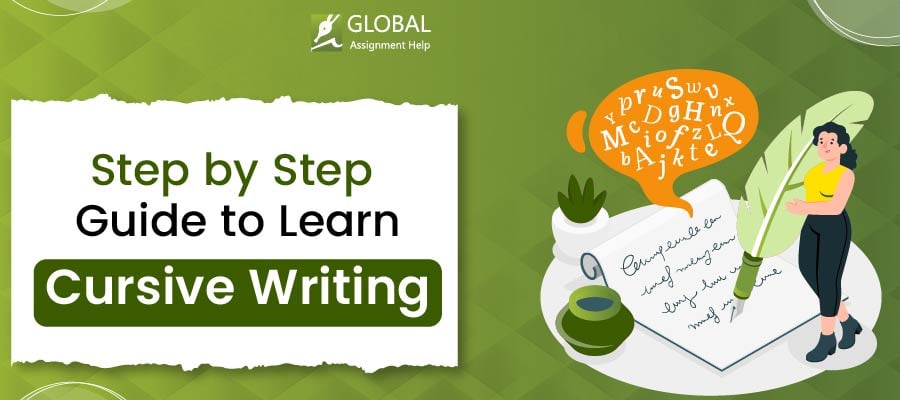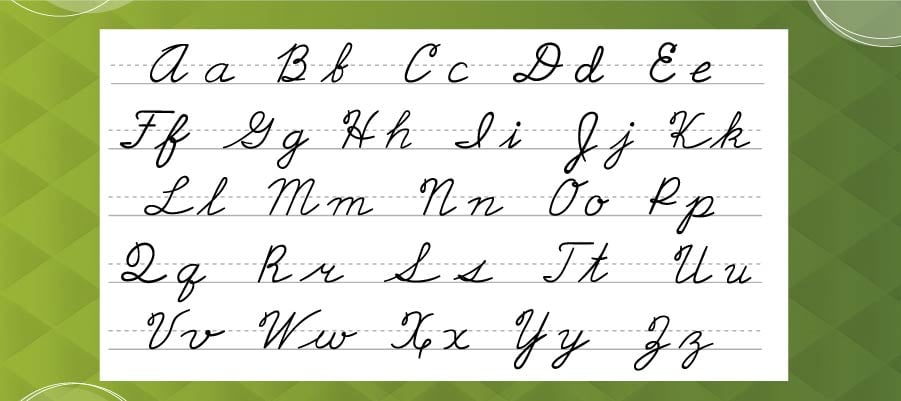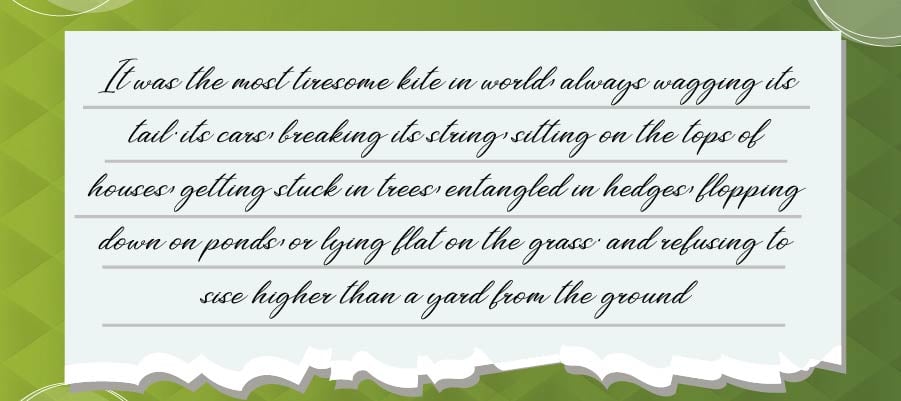How to Write in Cursive Writing: A Comprehensive Road-map

Do you know what cursive writing is and how to write in cursive? It is a style of penmanship in which characters are joined together in a continuous flow to write faster. Cursive writing was first found in a document written by Abraham Lincoln and Timothy Matlack around the 18th century. Transitioning from that time to now, it has become an essential element of calligraphy. However, in today's digital time, where everything is typed, cursive writing is still crucial for students or anyone who writes and uses the old traditional method. Thus, if you want to learn to write in cursive? So, do not worry; this blog is your perfect roadmap to learn how to write in cursive. So, let's begin!
Write In CursiveWhat is Cursive Writing? An Overview?
In simple terms, it is a style of writing in which you connect letters in a smooth flow; this flow and linking of letters make your writing more organized and neat. Before the existence of the typewriter, it was the preferred writing style used by professionals, such as lawyers, doctors, and more. It was called the fair hand and was considered the best to use in formal documents. However, now it has become an essential skill for great penmanship. Moreover, it helps enhance your cognitive skills and memory and has many benefits, which we will discuss later in this blog. Before knowing the benefits, let's understand the significance and how do you write in cursive, and why we must write in cursive.

Significance of Writing in Cursive
In today's world, where digital communication and typing have taken over the old traditional writing, learning to write in cursive is an acknowledgment and appreciation of our written language. Moreover, it's not about the tradition; cursive writing skills hold various benefits, which we will discuss in this section. So, let's begin without wasting a single second.
Historical and Cultural Connection
Learning how to write in cursive is connected to our culture and traditions; many crucial documents of our cultural heritage were written in cursive. So, when you learn to write in cursive, it's like paying homage to your traditions.
Adds a Personal Touch
Learning to write in cursive adds a touch of uniqueness to your expression of thoughts. Each individual's handwriting is different, adding a personal touch to your written work that is usually not present in the typed texts.
Beneficial for Brain
For children, it is one of the best mental exercises to enhance their memory; it is a cognitive exercise. Moreover, it enhances hand-brain coordination, which is helpful in the overall growth of the brain.
Useful for Formal Work
Everyone should learn to write in cursive because when dealing with formal documents and legal work, it is always suggested to write in cursive. So, everyone should learn to write in cursive. However, if you have doubts such as, “How to write in cursive for beginners?” Thus, it is suggested that you seek assignment help US.
Benefits of Learning to Write in Cursive
Learning how to write in cursive adds an element of uniqueness and aesthetics to your written text. Moreover, the appreciation showcases our appreciation towards heritage and culture. Moreover, in the digital age, where everything is typed, the advantages of learning cursive writing are commendable. So, let's dive into the numerous benefits of this style.
Better Writing Speed and Quality
Once you are used to the basics of connecting letters and how to write in cursive without making it untidy, then it will be easier for you to transfer your thoughts directly onto paper more smoothly. Moreover, the repetitive practice of writing in cursive enhances your memory capacity.
Enhances Critical Thinking
Writing in cursive lets you enhance the logical and creative side of your brain. Moreover, it sharpens your cognitive skills which enhances your writing and critical thinking skills. Furthermore, learning about the words to write in cursive can be difficult which makes your brain focus more while practicing. Overall, the more you try your hands on challenging or complex tasks, the more you will improve your critical thinking.
Better Memory
The unique pattern of handwritten letters is useful for your memory. The pattern of the connected letters improves your memory retention. This style of writing is very essential for children in their initial stages of learning how to write in cursive. This can lead to better memory retention and improved retaining power.
Fostering Focus and Comprehensiveness
The art of learning how to write in cursive requires focus and a good understanding of power, which is very crucial for shaping a better future for a kid. Moreover, learning calligraphy contributes to developing thinking capacities. So, after discussing the benefits, it's time to move on and learn how to write cursive letters. Before moving on to the next section, remember, that it is not just for aesthetics; it is a tool that helps engage their creative sides and improves memory, making it a very valuable attribute for the growth of young learners.
Methods to Write in Cursive
Now, we know the importance and benefits of this skill. It's time to transition to a step-by-step guide to learn this skill. In this section, we have tried to clarify how to write in cursive. So, let's jump into this ocean of cursive writing and explore the steps to write in this beautiful writing style.

Know the Basics
While starting to learn cursive writing, here are a few points that you can keep in mind:
- Note down every letter and understand the letter shapes.
- See how they are connected and observe their slants.
- Understand the strokes used, such as upstrokes, downstrokes, and loops.
Practice Lowercase First
After examining every letter, we will first begin with lowercase cursive writing. So, keep these points in mind:
- Practice forming each alphabet and master the art.
- Focus on keeping the shape of the slant correct.
- Ensure the connection of each letter is right.
Keeping these points in mind will ensure the correctness of the style while using it in academic tasks, formal documents, and italicized citation styles within research papers.
Switch to Uppercase!
After mastering the lowercase, gradually move to the uppercase cursive writing:
The uppercase letters have unique characteristics, so practice them accordingly.
Observe how these characters connect with the lowercase.
Moreover, if you need guidance with writing letters in cursive, you can use cursive sheets; copy letters, and trace them.
Now Combine Letters
After mastering the lowercase and uppercase, now combine letters using these tips:
- Start with combining lowercase and then uppercase.
- Try to keep the transition neat.
- Practice the common pairs of letters that are regularly used.
Now after combining the letters, let's move to the understanding and how to maintain a slant.
Develop a Consistent Slant
Slant is the most essential feature of cursive. So, paying attention to the slant is vital. Thus, try to keep the slant consistent throughout your text. Keeping these points will ensure you have an aesthetic and neat text.
Focus on Spacing
To keep your writing neat, spacing is vital. So, remember these points to ensure an organized write-up:
- Practice regular spacing between words; it will make your work tidy.
- Pay attention while spacing between connected letters.
- Avoid keeping them very close; it will lead to overcrowding.
Use these points to ensure clarity in your writing.
Work on Connecting Letters
The most aesthetic part of cursive is connecting the letters smoothly. Practice connecting them in a way that seems unforced and smooth like butter. Moreover, it should come in a flow. Remember, writing in flow is very essential for writing in cursive.
Explore Writing Styles
Understand, handwriting in cursive depends on the type of font you want to learn. Thus, in this section, we are going to discuss various writing styles and clear your doubts, such as “How to improve cursive handwriting?” Cursive writing has various fonts that you need to check out. Knowing these fonts will help you identify which suits you the best. So, here are some famous fonts:
- Allura
- Aguafina Script Pro
- Blackjack
- Caballero
- Columbine Light
- Kuenstler Script
- Fancier Script
- Lavender Script
- Shelley Script
- Citadel Script
- Buffet Script
- Hummingbird
- Creamy Script
- Ragazza Script
- Ritts Cursive
- Belinda
- Style Script
- Bendo Script
- Brody
Practice Regularly
Understanding, writing in cursive will require you to invest your time. Because it has various techniques that will be challenging for you initially, but with time you will get comfortable with it. Thus, to excel in this form of art, practice is the key. Make a fixed routine of writing in cursive. Moreover, understand that learning how to write letters in cursive is a time-consuming process, so be patient and enjoy the process.
So, these were the steps of learning to write in cursive. However, if you still have doubts, such as “How to write in cursive for beginners?", you can seek assignment help.
Place an Order
Place an OrderBonus Tips to Write in Cursive
After knowing the steps to learn writing in cursive, here are a few bonus tips, you must remember while practicing cursive writing.
- Initiate the learning process with lowercase letters; they are easier to grasp.
- Practice using the cursive writing sheets. Thus, copy or trace the letters, so it can be easy for your brain to memorize the patterns.
- After lowercase letters, move to tracing the uppercase letters.
- Keep the spacing in mind; it will ensure neatness in your work.
- Use the list of fonts mentioned above, and choose one that suits you, so you can practice and master it.
- Maintain the writing speed; start slow and gradually increase the speed.
- Do not rush the process of learning.
- Practice using cursive writing guides; there are guides available that can help you in writing cursive.
- Start practicing with easy letters such as O or U, as they consist of one stroke, and you will not have to move the pen. After mastering the easy ones, move to the complex letters.
So, these are a few tips that can help you learn cursive writing. Hope these tips helped you. Moreover, if you liked this blog, you can check out our commentary examples.
Facing Issues in Cursive Writing? Give Us a Shot!
So, this blog covered all the key points that will help you to learn how to write in cursive. Reading the definition and understanding the significance, benefits, and methods of writing in cursive. Moreover, the tips mentioned in the previous section will aid you more in grasping this crucial skill. However, if you still have any issues in learning to write in cursive, you can seek our guidance. We at Global Assignment Help can provide you with help with anything. Of course, it should be related to academics; our experts will guide you in writing cursive for your tasks. Moreover, we have top AI tools such as a plagiarism checker, an AI homework tool, and more. So, what are you waiting for? Give us a chance and kick out the stress of achieving academic excellence.
Frequently Asked Questions
1. How to Write Well in Cursive?
To familiarize yourself with the cursive alphabet. So, first of all. pay attention to both uppercase and lowercase letters. Ensure maintaining the slants and starting point of each alphabet. Moreover, to practise more you can download practice sheets.
2. What Is Cursive Writing in the USA?
The cursive writing style is also called the continuous writing style because of connecting letters. Once children learn to write a single letter, then they are taught to connect letters.
3. How to Write in Cursive for Adults?
First of all it does not matter that if you are an adult or a kid. You just need to be consistent, and use a systematic approach to learn to write in cursive.
4. How to Improve Cursive Writing Skill?
While learning to write in cursive, you should practice it daily, regularly writing same letters will help you memorize the complex patterns of each words. Moreover, you can use a pen or pencil, whatever suits you the most.
Free Tools

Easy to Use Paraphrasing Tool to Simplify Complex Academic Writing
Check Now
Get Structured Outline by Professionals for Your Dissertation
Check Now
Effortlessly manage citations and references with our smart referencing tool
Check NowLatest Blogs

- 30 Oct 2025
- 1276 Views

- 28 Oct 2025
- 143 Views

- 27 Oct 2025
- 254 Views

- 16 Oct 2025
- 262 Views
- Plagiarism
- Pricing
- Order Now
- Call Back
- Live Chat

Limited Time Offer
Exclusive Library Membership + Free 300$ Wallet Balance

Get $300 Now
Update your Number






















Thank you for submitting your comment on this blog. It is under approval. We will carefully review your submission and post it on the website.